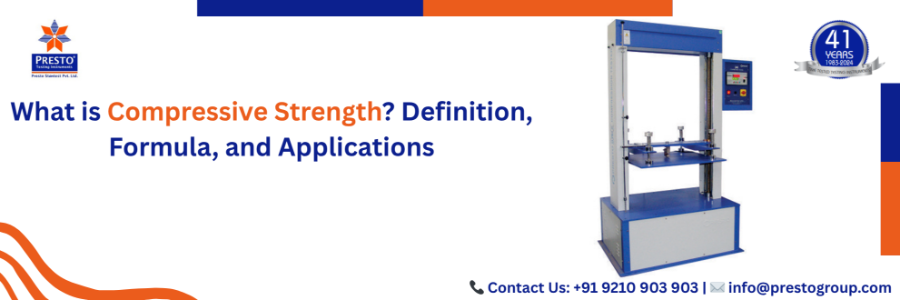

In the field of Engineering, compressive strength is an important concept. When a material is pushed or squeezed, its compressive strength is determined. Imagine pressing a piece of clay until it squashes; that is what compressive strength measures! In this blog, we will explain compressive strength in simple words, share its formula, describe how it’s tested, and explore its uses. We will also compare it with tensile strength, include a table, and answer four common questions. Let’s get started!
Compressive strength of a material is a strength that is determined when a material is pushed or squeezed until it changes its shape or breaks.
For example:- think of a concrete block in a building. The Concrete block is used to handle huge weights on it. So knowing the Compressive strength of these types of materials like concrete, metals, or bricks is an important part before starting a construction.
This strength is different from pulling strength (called tensile strength). Compressive strength is about resisting forces that try to crush or squash something.
The compressive strength formula is easy to understand. It is
Compressive Strength = Force ÷ Area
Or in symbols:
σ = F ÷ A
Where:
For example, a concrete block is pushed with 100,000 Newtons of force, and the surface area of the block is 0.02 square meters, then the compressive strength is:
= σ = 100,000 ÷ 0.02 = 5,000,000 Pa or 5 MPa
Using this number, the engineers decide whether the material is suitable or not.
The compressive strength of a material is tested using a compressive testing machine, which is also called a compressive strength machine. Under this machine, a sample of the material is kept, and the machine starts pushing it until it breaks, then it measures the forces required to break it. Below are the simple steps to calculate this:
Tests follow rules (like ASTM standards) to make sure results are accurate and can be compared.
Applications of compressive strength are all around us! This concept is used in many areas. Here are some,
Without compressive strength, we couldn’t build safe structures or products!
Tensile strength and compressive strength are different concepts, but they are in the same field. Both measure how strong a material is, but they deal with different forces. Here’s a simple comparison:
| Feature | Tensile Strength | Compressive Strength |
| What It Measures | How well a material resists pulling | How well a material resists squeezing |
| Force Type | Pulling or stretching | Pushing or crushing |
| How It Breaks | Snaps or tears apart | Cracks or squashes |
| Example Materials | Ropes, steel wires | Concrete, bricks |
| Used For | Cables in bridges | Building foundations |
For example, concrete is good in compression (squeezing) but not so good in tension (pulling). That’s why builders add steel bars inside concrete to handle pulling forces.
Compressive strength keeps things safe. If concrete used in a building is insufficient in handling compression, it is most probable that it would collapse. If a machine part is not capable of handling pressure, it may break and stop working. Testing compressive strength helps engineers pick the right materials, saving money and preventing accidents.
Testing compressive strength isn’t always perfect. Problems can include:
Engineers follow strict rules and check their equipment to avoid these issues.
Q1. What is a compressive testing machine?
Ans. This machine is used for materials like concrete and metals. It pushes a material solid sample and calculates the pressure required to break it.
Q2. How is compressive strength different from tensile strength?
Ans. Compressive strength is a material's resistance to crushing forces, while tensile strength is its resistance to being pulled apart. Concrete is strong in compression but weak in tension.
Q3. What’s the compressive strength formula?
Ans. It’s Force ÷ Area (or σ = F ÷ A). This shows how much force a material can take per unit of area before breaking.
Q3. Where is compressive strength used?
Ans. It’s used in building (like for concrete pillars), manufacturing (like for machine parts), aerospace (like for plane materials), and checking soil for construction.
When testing compressive strength, the machine you use matters a lot. Presto Stantest, a trusted company with over 40 years of experience, makes excellent comprehensive testing machines. Here’s why they’re a top choice:
If you are searching for an accurate and precise compressive testing machine, you can prefer and trust our Presto Stantest compressive testing machine. This machine is easy to use, and it is completely safe to use.
Compressive strength is a useful concept in the engineering sector. It helps us to build safe buildings, bridges, and products. Using the compressive strength formula and tools like the compressive testing machine, engineers can test materials and make smart choices. Whether it’s concrete in a skyscraper or parts in a plane, compressive strength keeps our world strong and safe!
Looking for the best deal on a Compressive Strength Machine? Get in touch with us today to get the latest Compressive Strength Machine Price. Call us at +91 9210 903 903 or email info@prestogroup.com for more details and personalized quotes!
Connect with us for your business enquiries. Generally, we respond within one or two working days.